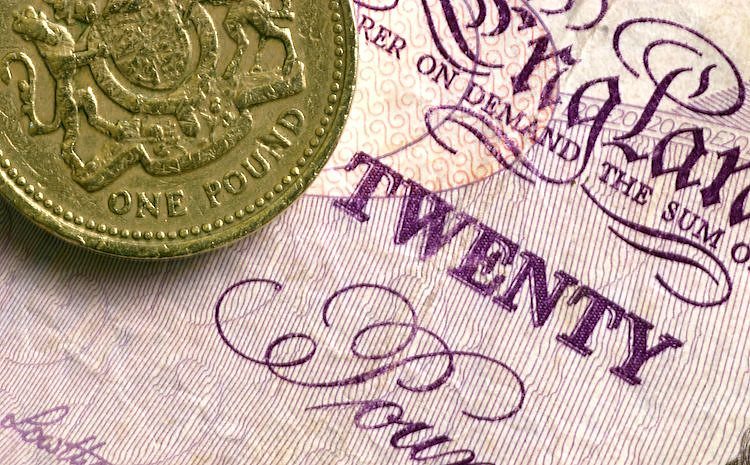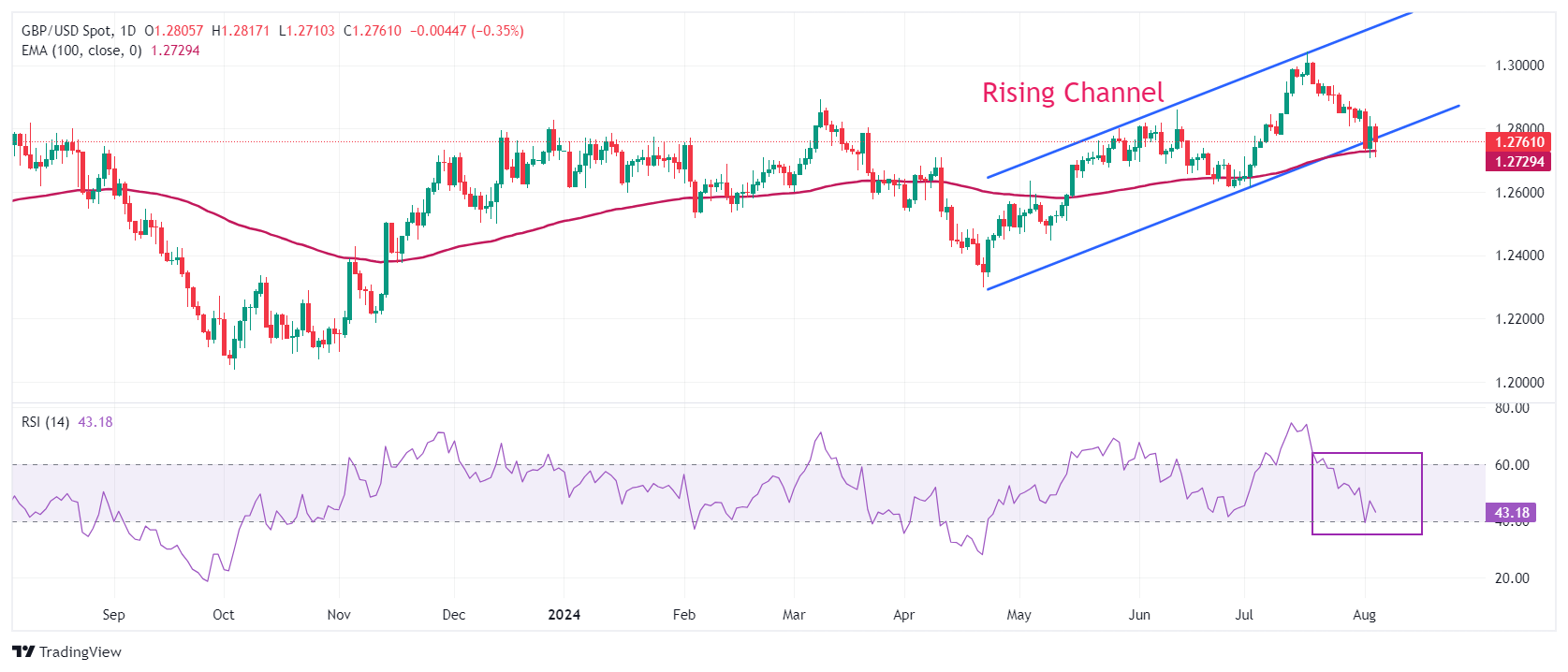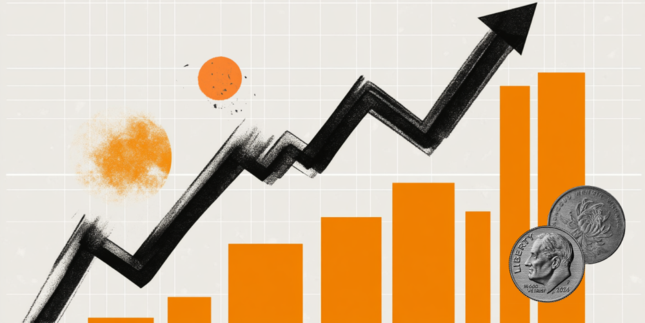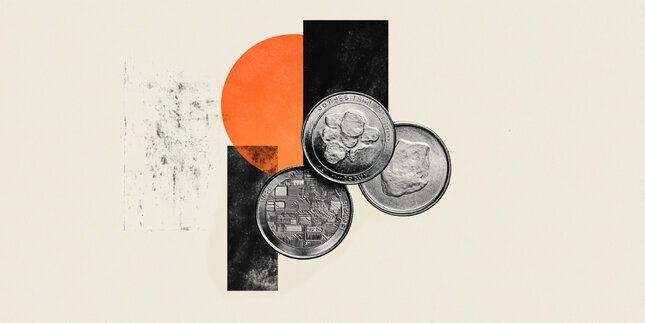Pound Sterling slumps as US economic slowdown prompts global risk-aversion
- The Pound Sterling declines against the US Dollar even though the latter plunges on firm Fed rate-cut prospects.
- Slowing US labor demand has prompted expectations of the Fed’s bulk rate cuts.
- Middle East tensions have escalated as Iran launched dozens of missiles on Israel.
The Pound Sterling (GBP) slumps to nearly 1.2770 against the US Dollar (USD) in Monday’s American session. The GBP/USD pair weakens as risk-aversion intensifies on deepening Middle East risks. Also, the Cable drops sharply despite the plummeting USD. The US Dollar Index (DXY), which tracks the Greenback’s value against six major currencies, plunges to near 102.40, the lowest since March 11.
The US Dollar has been hit hard badly by firm speculation that the Federal Reserve (Fed) will reduce interest rates by 50 basis points (bps) in September. Also, traders have priced in more than 100 basis points (bps) rate cuts this year. The expectations of the Fed’s bulk rate cut were boosted by easing United States (US) labor market conditions and contracting activities in the manufacturing sector.
The US Nonfarm Payrolls (NFP) report for July showed that fresh payrolls came in lower at 114K than estimates of 175K and June’s reading of 179K. The Unemployment Rate jumped to 4.3% from expectations and the prior release of 4.1%. Meanwhile, activities in the manufacturing sector, as measured by the Manufacturing Purchasing Managers Index (PMI), contracted at a faster pace to 46.8 in July from the prior release of 48.5. A slew of weak economic data indicates that the economy struggles to bear the consequences of higher interest rates, which point to a slowdown ahead.
Meanwhile, US ISM Services PMI data for July has outperformed expectations. The report showed that activities in the services sector returns to expansion after contracting in June. The PMI rose at a faster-than-expected pace to 51.4 from estimates of 51.0 and the prior release of 48.8.
Daily digest market movers: Pound Sterling weakens on dismal market sentiment
- The Pound Sterling exhibits a weak performance against its major peers, except Asia-Pacific currencies, in Monday's New York session, as dismal market sentiment has dampened the appeal of risk-sensitive assets. Growing Middle East tensions and fears of an economic slowdown in the United States (US) have improved the appeal of safe-haven assets, such as the Japanese Yen (JPY) and the Swiss Franc (CHF).
- Tensions between Israel and Iran have turned into an all-out war after Iran-backed Hezbollah confirmed that the group launched dozens of missiles at Israel on Saturday. Iran vowed to retaliate against the assassination of Hamas leader Ismail Haniyeh by an Israeli airstrike in Tehran. The nation said last week that Israel has to pay the price for Haniyeh’s killing.
- On the domestic front, the British currency will be influenced by market speculation about whether the Bank of England (BoE) will deliver subsequent rate cuts in September. Last week, the BoE reduced interest rates by 25 basis points (bps) to 5%, with a 5-4 vote split, as expected. On the interest rates outlook, the BoE refrained from committing to a pre-defined rate-cut path.
- In the press conference, BoE Governor Andrew Bailey said, "We need to make sure inflation stays low, and be careful not to cut interest rates too quickly or by too much." About the United Kingdom (UK) service inflation outlook, Bailey commented, "Services price inflation may rise slightly in August before easing in the rest of the year."
Pound Sterling Price Today:
British Pound PRICE Today
The table below shows the percentage change of British Pound (GBP) against listed major currencies today. British Pound was the strongest against the Australian Dollar.
| GBP | EUR | USD | JPY | CAD | AUD | NZD | CHF | |
|---|---|---|---|---|---|---|---|---|
| GBP | -0.89% | -0.60% | -3.43% | -0.60% | 0.51% | -0.22% | -1.64% | |
| EUR | 0.89% | 0.16% | -2.76% | 0.14% | 1.27% | 0.54% | -0.88% | |
| USD | 0.60% | -0.16% | -2.88% | 0.00% | 1.00% | 0.38% | -1.03% | |
| JPY | 3.43% | 2.76% | 2.88% | 3.00% | 3.94% | 3.37% | 1.93% | |
| CAD | 0.60% | -0.14% | -0.01% | -3.00% | 1.03% | 0.38% | -1.22% | |
| AUD | -0.51% | -1.27% | -1.00% | -3.94% | -1.03% | -0.72% | -2.14% | |
| NZD | 0.22% | -0.54% | -0.38% | -3.37% | -0.38% | 0.72% | -1.42% | |
| CHF | 1.64% | 0.88% | 1.03% | -1.93% | 1.22% | 2.14% | 1.42% |
The heat map shows percentage changes of major currencies against each other. The base currency is picked from the left column, while the quote currency is picked from the top row. For example, if you pick the British Pound from the left column and move along the horizontal line to the US Dollar, the percentage change displayed in the box will represent GBP (base)/USD (quote).
Technical Analysis: Pound Sterling trades below 1.2800
The Pound Sterling is at a make-or-break near the lower boundary of the Rising Channel chart formation on a daily timeframe. Historically, a pullback move in the aforementioned chart pattern is considered a buying opportunity by market participants.
The GBP/USD pair fell on the back foot after breaking below the crucial support of 1.2900 on July 25. Meanwhile, the 100-day Exponential Moving Average (EMA) near 1.2730 has acted as major support for Pound Sterling bulls. The 14-day Relative Strength Index (RSI) declines to near 40.00, which is expected to act as a cushion for the momentum oscillator.
On the upside, the round level of 1.2800 will be a crucial resistance zone for the Pound Sterling bulls. Further up, the two-year high near 1.3140 will be a key resistance zone for the pair.
Risk sentiment FAQs
In the world of financial jargon the two widely used terms “risk-on” and “risk off'' refer to the level of risk that investors are willing to stomach during the period referenced. In a “risk-on” market, investors are optimistic about the future and more willing to buy risky assets. In a “risk-off” market investors start to ‘play it safe’ because they are worried about the future, and therefore buy less risky assets that are more certain of bringing a return, even if it is relatively modest.
Typically, during periods of “risk-on”, stock markets will rise, most commodities – except Gold – will also gain in value, since they benefit from a positive growth outlook. The currencies of nations that are heavy commodity exporters strengthen because of increased demand, and Cryptocurrencies rise. In a “risk-off” market, Bonds go up – especially major government Bonds – Gold shines, and safe-haven currencies such as the Japanese Yen, Swiss Franc and US Dollar all benefit.
The Australian Dollar (AUD), the Canadian Dollar (CAD), the New Zealand Dollar (NZD) and minor FX like the Ruble (RUB) and the South African Rand (ZAR), all tend to rise in markets that are “risk-on”. This is because the economies of these currencies are heavily reliant on commodity exports for growth, and commodities tend to rise in price during risk-on periods. This is because investors foresee greater demand for raw materials in the future due to heightened economic activity.
The major currencies that tend to rise during periods of “risk-off” are the US Dollar (USD), the Japanese Yen (JPY) and the Swiss Franc (CHF). The US Dollar, because it is the world’s reserve currency, and because in times of crisis investors buy US government debt, which is seen as safe because the largest economy in the world is unlikely to default. The Yen, from increased demand for Japanese government bonds, because a high proportion are held by domestic investors who are unlikely to dump them – even in a crisis. The Swiss Franc, because strict Swiss banking laws offer investors enhanced capital protection.
Forex News
Keep up with the financial markets, know what's happening and what is affecting the markets with our latest market updates. Analyze market movers, trends and build your trading strategies accordingly.
























